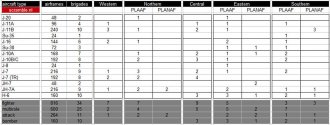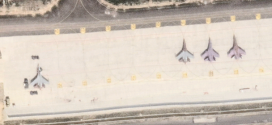I think a total J-16 procurement count (not including J-16D) could end up around 300 for PLAAF and PLANAF combined, with the PLANAF having maybe something like 60+ J-16s divided between three smaller sized brigades, with the long term view of handing them to PLAAF and eventually becoming a fully carrierborne fighter fleet.
The question is why would PLANAF expend resources to introduce J-16s into service temporarily? If they planned on using J-16s there would be already an unit either operating them or in the process of introducing it into service. Case in point: J-11B. Logistics and training for an unit takes more time and resources than a new production lot. Therefore I don't think it is going to happen.
From scramble (early 2021 - see table below) PLANAF has the following
land-based fighter units:
Northern TC:
2x JH-7A
1x J-8
Eastern TC:
1x Su-30
1x J-10A
2x JH-7
Southern TC
3x J-11B
1x JH-7A
When we look at the composition of units and remember when they were equipped with those aircraft types it's obvious that it's a limited land-based substitute of carrier aviation improvised in the absence of true multirole aircraft. That also might be the reason why you imagine J-16 should be introduced into the force as it is the "Super Hornet" of PLA, especially with J-16D coming along. However this seems to follow from Bltizo's tendency to treat existing American solutions as rationally planned optimal choices instead of product of chaotic cuts, budget wars and MIC meddling. I tend to view most of American procurement in the last 30 years in the latter category.
To me there is no rationale for J-16s in PLANAF service in the long term, let alone temporarily. J-15B/D and next generation fighter are the logical and obvious choice from the manufacturing, logistical and operational standpoint. The only instance where J-16 could be used was if J-15 couldn't come in a two-seater variant for D version. Is that the case? If not all you need to do is compare manufacturing and part divergence between F-35A and F-35C to realize that mixing two types of aircraft is not good. There's a reason why USN cut down its combat aviation to F/A-18E/F/G and was force-fed F-35C.
My view is this:
The prudent and economic decision is to upgrade JH-7A to A2 standard and replace JH-7s with JH-7A/A2 from PLAAF which in turn will be replaced by new J-16s. PLAAF both needs more J-16s and can benefit from the increasing economies of scale. They can also perform the missions that PLANAF J-16s would do better - as evidenced by the recent exercises near Taiwan. PLANAF needs an update to the weapons and sensors of its existing land-based aircraft, not new land-based aircraft to throw the entire logistical chain out of the window.
Southern J-11B will be replaced by J-15B which can operate both from land and deck making it logistically much more appropriate for SCS and beyond and also it will be a better starting point for future carrier wings. There's already one carrier there and units can take turns being deployed.
J-11B will be either transferred to PLAAF to replace J-11As or to ETC to replace J-10s and Su-30s. I think that J-10A unit was either used for tests and was considered unsatisfactory or it was an accident of availability which is why there only is one unit with this aircraft in all of naval aviation. Both of those units will be used as a basis for future carrier wings whether in ETC or the other two which will be easier as they move from J-11B to J-15B. Upgraded JH-7A2 will balance the loss of strike capability from Su-30s.
PLAAF is in a different situation. Again from early 2021's scramble:
 Disclaimer: The table only list units so the numbers of airframes will not correspond to known production lot numbers
Disclaimer: The table only list units so the numbers of airframes will not correspond to known production lot numbers. The number of airframes is the nominal brigade multiplied by the number of units. This is why the number for J-11B is higher than the known production. It's a visual aid and a crude one but it is helpful if you don't carry all the data in your head.
Treat the numbers as identical "slots" where aircraft can be moved from unit to unit. If a retired J-7 is replaced with active J-11B and retired J-11B is replaced by new J-16 it doesn't matter if J-7 or J-11 is replaced by J-16 because we're only interested in J-16 numbers.
All PLAAF J-11A and Su-30 units will have to receive J-16s
if they are to retain their current location and operational range - this is a logistical constraint that seems like a rigid requirement. You either have a long-range aircraft or not. That is 144 J-16s.
All JH-7As are potentially replaceable by J-16s - that's another 144 aircraft. All of those can theoretically be replaced by J-20 and JH-XX but it is impossible guess what the production rate will be and which units will receive which types. It should increase from what it is now but how much and when?
J-7s will also be replaced but there are already additional J-10s. The rest is up to shuffling of existing active aircraft. Therefore the total threshold for J-16 and J-16D production is 288. I would expect that an attrition reserve will be established at a sensible rate (15% minimum, 30% ideal) in the future once the numbers are up and therefore even including J-20s and JH-XX the number of 200 J-16 and J-16D in production is reasonable as they will replace aircraft inferior in capability.
As for the role of J-16D and speculative numbers:
If USN operations are any indication on how such aircraft can be used then one brigade or brigade-equivalent per theater command should be the sufficient number as it would be the equivalent of two Growler squadrons per theater. That puts the upper threshold at ~120 airframes. The only question is if these aircraft will serve in newly formed brigades or will replace existing attack aircraft - say JH-7.
I don't expect J-16 and J-16D to be mixed as part of a brigade since EW mission profile and training is very different from regular combat mission. Carrier Air Wings are "bases" and therefore the only thing that links a Growler squadron and a Rhino squadron is location at sea.
My posts on Desert Storm have tables on EF-111A and EA-6B numbers that can also serve as an indication of what proportion of EW aircraft is used for air missions - in this case in actual combat and extensively. I'm currently going through part V of the Survey which has detailed data on every day of operations but it will take me some time before I can extract any additional information - if there is any.






